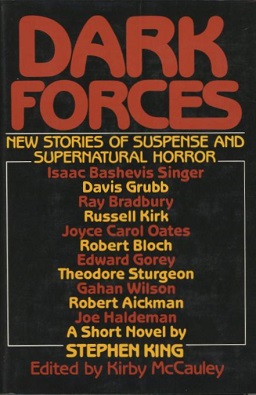Today I dropped by a used book store. I headed first over to the mystery section, and picked up one paperback under the Soho Crime imprint. Then I looked at the science fiction section, but found nothing of interest. I glanced at the horror section, which usually is dominated by two authors, both whose last name starts with the letter “K.” One of the hardcover books positioned to face out on the shelf was a book I’d see years ago. I thought I had once owned a copy, maybe a paperback or such, and almost walked away. But, it was a hardcover in decent condition, even with a mylar protective cover, and I knew it was a book I currently didn’t have. There was a small water stain on the top, but otherwise it looked ok. The price was $8.49. I opened the cover and saw someone had penciled Xs and check marks next to the stories. That’s ok, I thought. I can erase those.

After I bought the book, I realized someone had written a name on a page just before the table of contents. It was the editor’s name, Kirby McCauley. Well, I thought, maybe the previous owner kept track of the authors. Later than evening I did a lazy search online for McCauley’s signature, and it matched. Not too bad, signed by the editor. I erased the pencil marks, then flipped to the first story. At first, my heart sank. I hate it when people write in books, and someone had written the date above the title of the story. Then I saw a faint signature below that. The story had been signed by the author, Dennis Etchison. I flipped to the second story, and Ed Bryant had signed that one as well. Story after story had been signed by the contributor—13 of the 24 contributors had signed or inscribed the book. A few were dated 1982. The others were undated. The previous owner had somehow been able to collect signatures from the following people:
• Kirby McCauley
• Stephen King
• Dennis Etchison
• Edward Bryant
• Karl Edward Wagner
• Gene Wolfe
• Theodore Sturgeon
• Ramsey Campbell
• Robert Bloch
• Ray Bradbury
• Joe Haldeman
• Charles L. Grant
• Manly Wade Wellman
I have no idea what a book like this, with signatures from Stephen King, Ray Bradbury, Robert Bloch, and others, might be worth, but this probably ranks up there as perhaps the greatest or luckiest find in my book collecting life, ever.
The previous owner had bought the book over 40 years ago, had gone around to conventions and collected signatures from authors who were either famous or on the way to great fame. What happened to the previous owner for the book to end up in the used book store, and sold for only $8.49? The book store people had no idea who signed the book. If they had, it would be behind glass with a much higher price.
Most of the contributors are now dead. I think of the ones who haven’t signed it, only three remain alive. It would be cool if even one or all were signing books somewhere and I was able to make it there, that their names could be added to this book. What history lies within, nestled among these great stories!